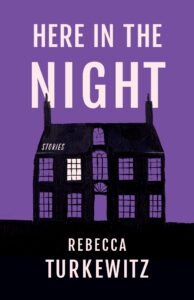When Scream came out in 1996, it broke one of the cardinal rules of horror film––the characters in the movie watched and loved scary movies.
The characters in Rebecca Turkewitz’s debut collection, Here in the Night (Black Lawrence Press), love to tell a good ghost story. In “At This Late Hour,” the specter of a local legend clouds the social forces which women negotiate in a small town in New Hampshire. In “Warnings,” a girl’s cross country team groans about running together until a teammate goes missing, becoming the missing girl from the warnings they’ve been given. “The Last Unmapped Places,” one of the collection’s most propulsive and evocative stories, looks at the narratives that shape the lives of a pair of twins, from childhood through their adult lives. Through its attention to storytelling, the collection investigates both the social forces that assert their presence on the narrators’ lives––conformity, misogyny, homophobia––and the role that folklore, nightmares, and urban legends play in enforcing certain social codes.
Rebecca Turkewitz is a public school teacher based in Portland, Maine, where she spoke with CrimeReads about ghost stories, true crime, and the ways that narratives shape our lives.
Michael Colbert: We’re speaking in Maine; both the state and New England have a particular tradition of ghost stories. What makes the region so ripe for ghost stories in your mind?
Rebecca Turkewitz: I think a lot of it has to do with its literary history: Lovecraft, Stephen King, and Shirley Jackson are all part of it. And then the landscape––the joke is that in every movie about Maine it’s really foggy, but I feel like it’s kind of true.
MC: For a visual, we’re speaking on a very foggy day in Maine.
Debutiful said that your “stories are R.L. Stine for adults.” These stories are about hauntings of a much more realistic nature––grief, loss, disappearances, life changes. What haunts us as we age? How does Goosebumps grow up?
RT: I was such a Goosebumps fan when I was a kid. I was obsessed with them––it’s embarrassing. I also think my characters are dealing with a lot of deeper issues. When I think about ghosts and monsters, I think for adults a lot of times it is about grief. That comes up in a lot of the stories, and loss, and thinking about the past, and the way the past prompts the future. As you get older, how do you reconcile your personal history and the history of a place? I think you think about death more, or you think about time more, or you think about change.
MC: Did you have other horror influences or ghost stories that you were thinking about?
RT: I’m a huge Shirley Jackson fan. I’m always just in awe and trying to write towards that. I do love Stephen King. The Shining is one of my favorite books. I also love Dan Chaon and his book, Stay Awake. I read White is for Witching by Helen Oyeyemi when I was writing. I also was thinking about—and aspiring towards—the way writers like Jesmyn Ward and Toni Morrison use ghosts. I’m thinking of Beloved and Sing, Unburied, Sing. Those are ghost stories, but they’re not spooky. I think I was trying to meet somewhere in the middle of spooky and ghosts as a way to get at something deeper thematically.
MC: What draws you to the ghost story? Why is that an evocative genre?
RT: Kelly Link is also a huge influence. Someone asked her a really similar question, and she was like, “Well, who doesn’t love ghost stories?”
MC: That’s so true.
RT: I love that quote because it’s true if it’s true for you, but it’s not true for a lot of people. My mom will read my work and be like, I don’t get it. I think that for people who like ghost stories, it’s like, who doesn’t love a ghost story? Which I know is not true. I know there are a lot of people who don’t like ghost stories. Since I was kid, I’ve just loved them. It’s hard for me to articulate why.
MC: With the collection, it felt more like you’re working in the mode of ghost stories as opposed to horror; spooky as opposed to scary and gory.
RT: Talking to people who write or read horror, they say, “Oh this book is not horror; it’s just ghost stories.” But then talking to people who read more literary work, they’re like, “Well this is a horror book.”
MC: A lot of the stories have this moment when a character comes into the ghost story, like in “At This Late Hour” or “Crybaby Bridge.” I was thinking about the power of narrative within the stories. What interests you about local legends, true crime, or ghost stories as a social force?
RT: I’m obsessed with stories within a story. And I also love local legends. I love oral folklore and local history. I read a lot of true ghost stories, which Maine has plenty of. I’m very preoccupied with the way that people interact with stories. I think these types of stories help people connect to different places and understand their relationship to that place and its culture. In my life, I do that. I seek out these types of stories, so the characters are doing similar things.
MC: Were there any particular stories from the real world that you drew upon to inspire these stories?
RT: There are a few. “The Elevator Girl” is set at OSU, where I went to grad school. The art building there is haunted. To be honest, I don’t truly believe in ghosts. But there is a story about an art student who haunts the elevator. The real story does not have a lot of details that are in “The Elevator Girl.” I was really drawn to that I think because, like in the story, she doesn’t die in the elevator—she dies later. I like when ghost stories have really weird details. So then I was thinking about why the elevator would be haunted, and the story stemmed from that.
“The Attic” is not based on any particular legend, but in the Midwest, there are a lot of legends about telekinetic children. And “Crybaby Bridge” is a big Midwest legend. There’s a lot of bridges that are called crybaby bridge.
MC: The titular story takes place in the wake of the Pulse shooting. The couple processes the news differently. What were you thinking about with that story?
RT: Even though it’s tonally different than some of the ghost stories, I think it’s a similar preoccupation with the way stories shape our personal lives. I think that was an event that affected queer people in very different ways. In my friend group, we had really different responses to it; I was interested in that. I also was interested in, as a queer person, what does it mean to be unsafe in the world.
MC: With that story, there’s this question of how the two women felt the immediacy of the event. Thinking of safety, for one it’s closer and for the other it’s further.
RT: I’m not a very autobiographical writer. In terms of life details, there’s not a lot of similarity. But the story that she tells about the gay man in the south who the funeral home wouldn’t bury, that actually did happen a couple years before, and I had this very strong reaction to it. I was still thinking about it and wondering why, because it had nothing to do with me. I lived in Columbus, Ohio, and pretty much all my life I’ve lived in places where it’s pretty safe to have people know that you’re queer. And then I was just fascinated by that. I was wondering why I was having this reaction to it.
MC: Do you think ghost stories have a power to enforce a social code or set of politics? Do they ever become a restrictive force?
RT: I think sometimes. I think it’s both a reflection of a culture and also a way of reinforcing it. When you look really closely at a lot of ghost stories or fairy tales, they are enforcing a certain ideal or world that they want.
MC: I really loved “The Last Unmapped Places.” I was particularly impressed by the narrative elasticity and control. What was on your mind as you wrote?
RT: I think that’s probably my favorite story too. It was the last one in the collection that I wrote. I wrote it over two years, and I think that’s part of it. I really wanted to be narratively ambitious with that story. More than with other stories, I could see what the story would be. I wrote the beginning and the end in this week that I was at the Hewnoaks Artist Residency. And then that summer, I sort of wrote a draft and thought all I had to do was revise. I kept doing a little bit and then putting it away. I think I was always scared that it wouldn’t work, but I could see a world in which it worked.
MC: It’s different than the other stories. The telling of the story itself mimics some of the questions of ghost stories: how does a personal story become the organizing thread of a life? How do you look back on the past? You see that working in the story through its play with time. What else is exciting to you in fiction right now?
RT: Right now, there’s a lot of amazing short story collections coming out. Paul Tremblay’s The Beast You Are comes out in July, and I’m super excited to read it. I just finished Tomorrow and Tomorrow and Tomorrow, which blew my mind. I’m reading She Is a Haunting by Trang Thanh Tran and a poetry collection by Mary Biddinger called Department of Elegy, which is about the post punk era in Ohio. I feel like I’m reading super eclectically. For a while when I was finishing the collection, I was reading a lot of spooky stuff, and now I’ve just been reading all the other things that I’ve been interested in.
MC: What are you working on now?
RT: I’m finishing a short story that’s thematically similar to the book. In theory, I have an idea for a novel that I was supposed to already be working on. I’ve been working on short stories for so long. It’s really hard to get out of that. In undergrad, I thought I was going to write a novel and then I fell in love with short stories. I want the challenge of writing a novel, but I keep coming up with story ideas. A couple years ago, I started writing flash fiction. I’ve done a lot of that, which is really good for me working full time. I write mostly in the summers and breaks, but flash I can write whenever.
I also want to shout out to Black Lawrence Press. It’s been amazing working with them. Writers often don’t know anything about promotion or publishing, and I think that they have been really good at illuminating the next steps. It’s been a great learning experience.


















